Noticias
which is the best AI art generator in 2025?
Published
9 meses agoon
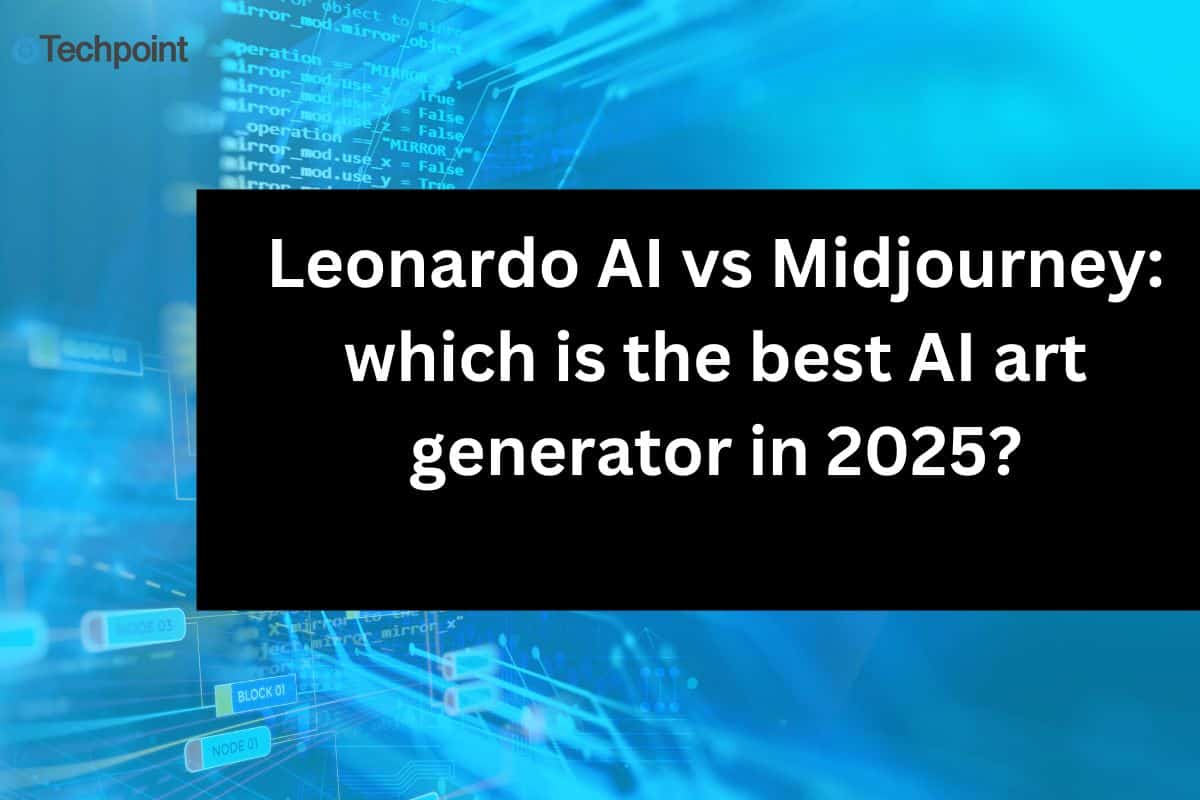
AI art generators have revolutionized the creative artistic space, allowing artists, designers, and enthusiasts to generate stunning visuals with unprecedented ease.
As a specialist digital marketer turned AI-curious creator, I’ve spent years bouncing between tools that promise “revolutionary creativity” for my content pieces. But in 2025, two AI powerhouses, Leonardo AI and Midjourney, loom over the AI art scene. Both claim to translate imagination to gallery-worthy pixels without mangling the vision.
But here’s the raw truth: After living double lives for 21 days, being a Midjourney evaluator by day and Leonardo AI experimenter by night, I’ve seen them at their best, worst, and weirdest.
In this review, I’ll share my experience with these tools, exploring their onboarding processes, user interfaces, core features, pros and cons, and practical usages. I’ll also offer personal verdicts to inform your decision when assessing these AI art generators for your needs.
Key takeaways
- On User Interface and Experience: Leonardo AI offers a sleek and intuitive web interface, making it easy for beginners and experienced users to navigate. However, its extensive customization options might overwhelm newcomers.
Midjourney operates via Discord, which can be challenging for those unfamiliar with the platform. However, it fosters a strong community aspect.
- On Customization and Versatility: Leonardo AI excels in customization, allowing users to adjust various parameters for tailored outputs. It also enables users to train their own models, offering a high degree of versatility.
Midjourney provides customization but is more focused on spontaneous artistic interpretations. It relies heavily on text prompts for style adjustments.
- On Image Quality and Style: Leonardo AI is renowned for generating high-resolution, photorealistic images, making it ideal for professional applications.
Midjourney produces vibrant, artistic outputs, often preferred for creative experimentation and unique styles.
- On Community and Support: Midjourney benefits from a strong Discord community, which is integral to its user experience. Users can share creations and receive feedback.
Leonardo AI offers comprehensive support resources, including a help center and direct messaging, but lacks a community-driven aspect.
- On Pricing and Accessibility: Leonardo AI provides a generous free tier with API credits, though premium plans can be costly. It’s ideal for those needing customization and control. It’s now available on Google Play Store and iOS.
Midjourney no longer offers a free option, with monthly plans starting at $10. It’s more straightforward in pricing but requires a financial commitment.


Let the best of tech news come to you
Join 30,000 subscribers who receive Techpoint Digest, a fun week-daily 5-minute roundup of happenings in African and global tech, directly in your inbox, hours before everyone else.
What’s Leonardo AI?
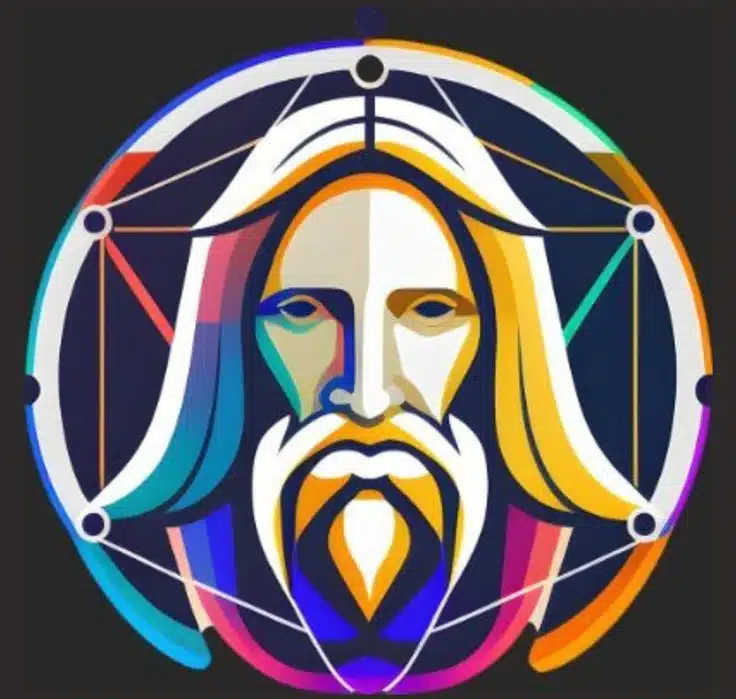

Leonardo AI is an advanced AI image generator designed to create high-quality visual assets. Launched in December 2022 by founders JJ Fiasson, Ethan Smith, and Jachin Bhasme, this platform has rapidly gained popularity, amassing seven million users who have created over 700 million images.
Leonardo AI leverages technologies like generative adversarial networks (GANs) and diffusion models to produce detailed, engaging images based on user input.
With its robust AI technology, Leonardo AI supports industries like gaming, advertising, and fashion, transforming content creation by making it faster and more accessible.
What’s Midjourney?


Midjourney is a pioneering AI image generator launched in July 2022 by David Holz, co-founder of Leap Motion. Developed by an independent research lab in San Francisco, Midjourney transforms text prompts into stunning images, ranging from photorealistic scenes to abstract art. The platform is notable for its high-quality outputs and active community of over 20 million users who access it via Discord or a recently introduced webpage.
Midjourney’s AI leverages natural language processing and machine learning, allowing users to customize images with precision. The platform offers features like the “Vary (region)” tool, which enables users to modify specific parts of an image. With continuous updates, such as the latest V6.1 model, Midjourney remains a leading digital art and design tool, providing a versatile and collaborative environment for artistic professionals and hobbyists.
Getting onboard on the Leonardo AI and Midjourney platforms
Leonardo AI
Leonardo AI offers a straightforward sign-up process. I created an account and accessed the platform via a web interface by clicking the “Start Using Leonardo AI” button.
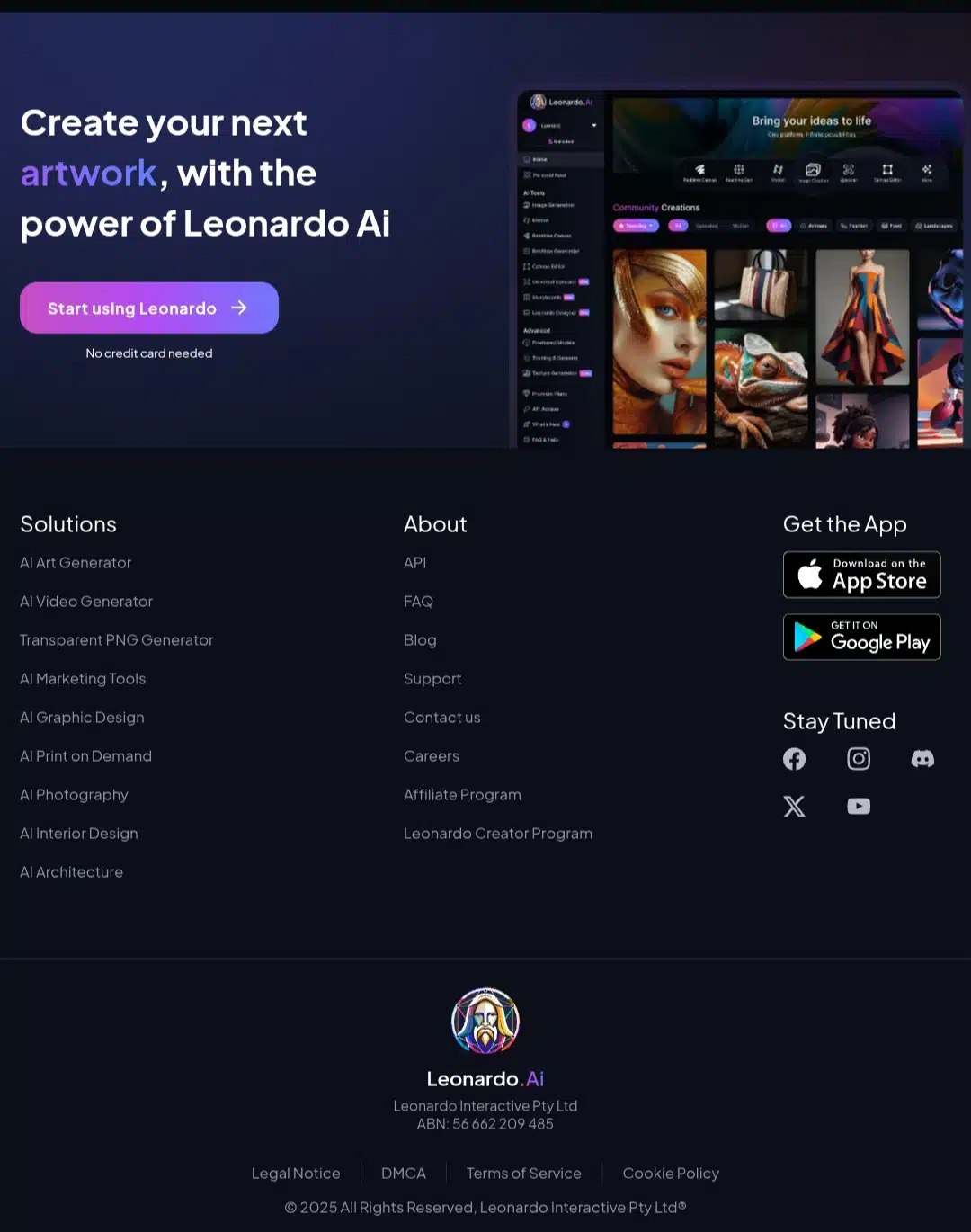

There, I signed in with my email, among other options.
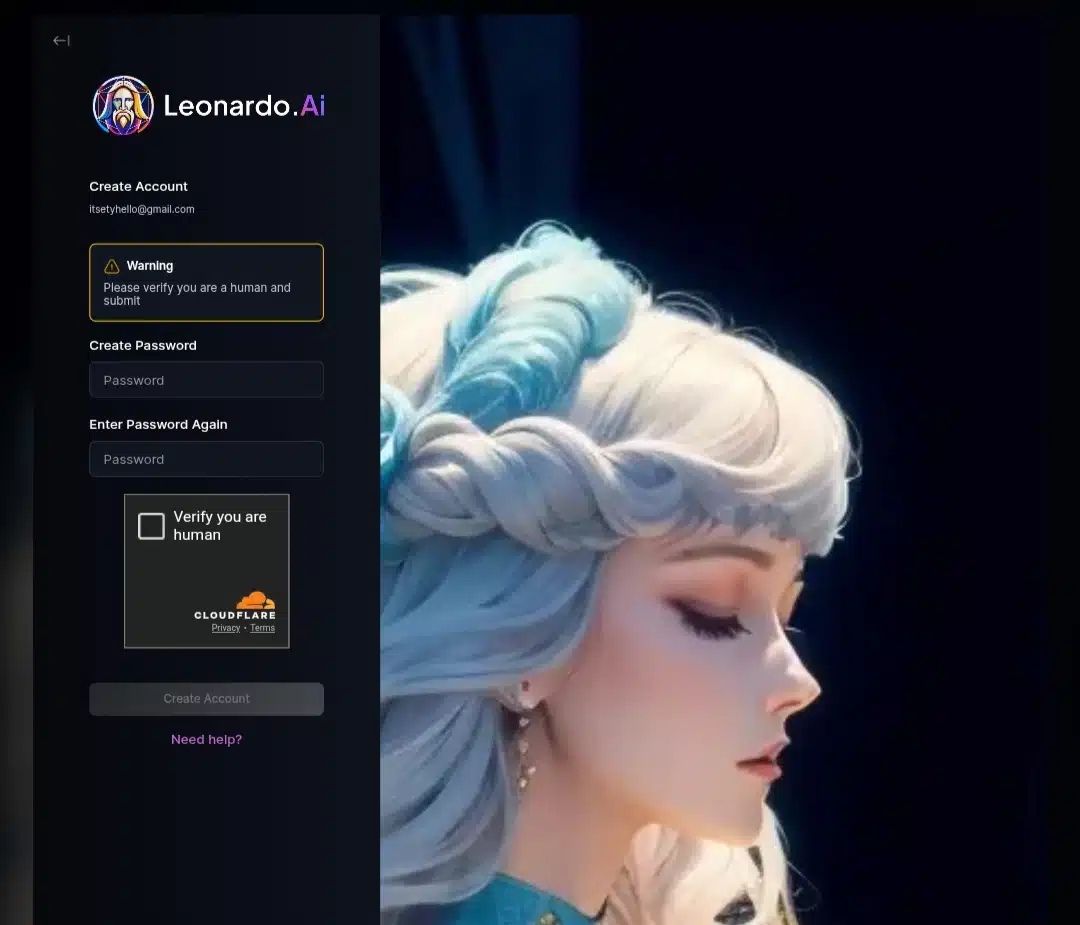

Next, I formed a strong password according to the requirements, and a verification code was sent to my email.
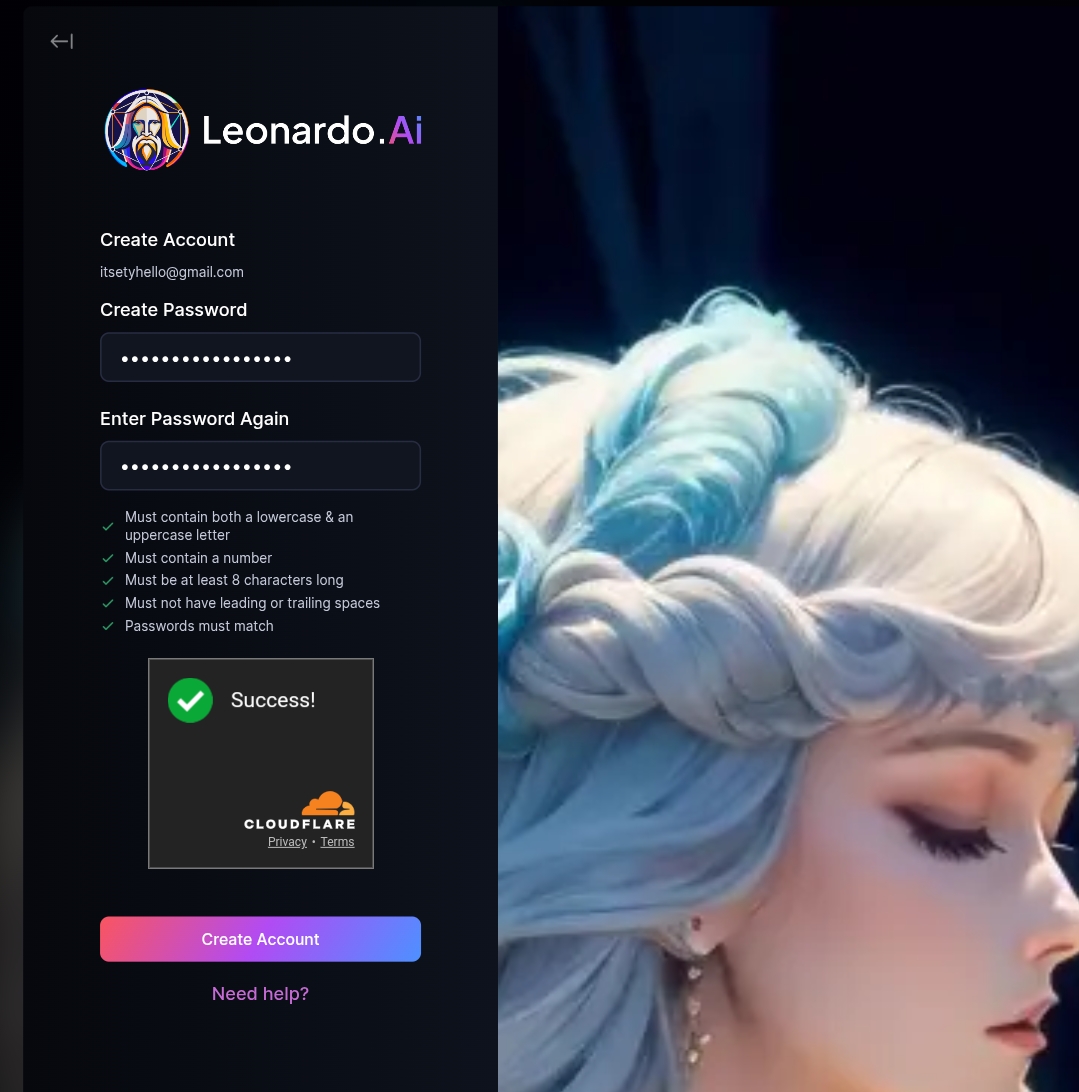

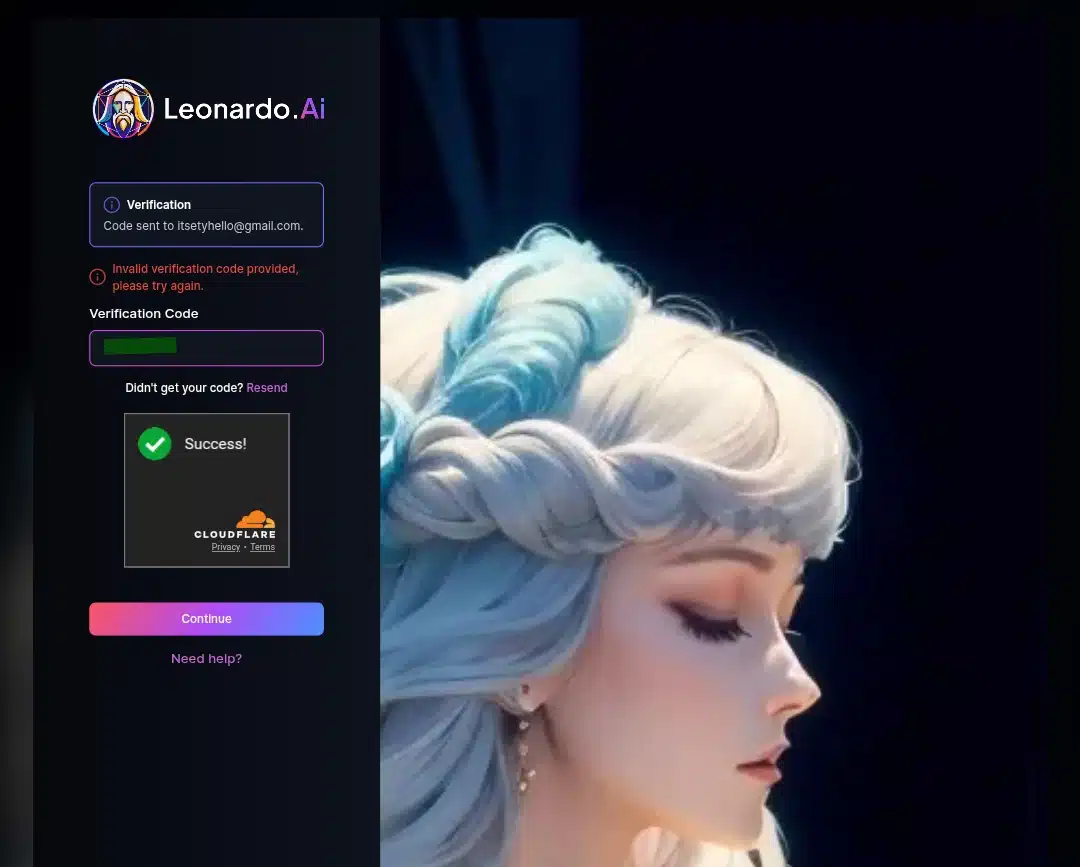

I inputted it, and it was Successful.
Next, I chose a username.
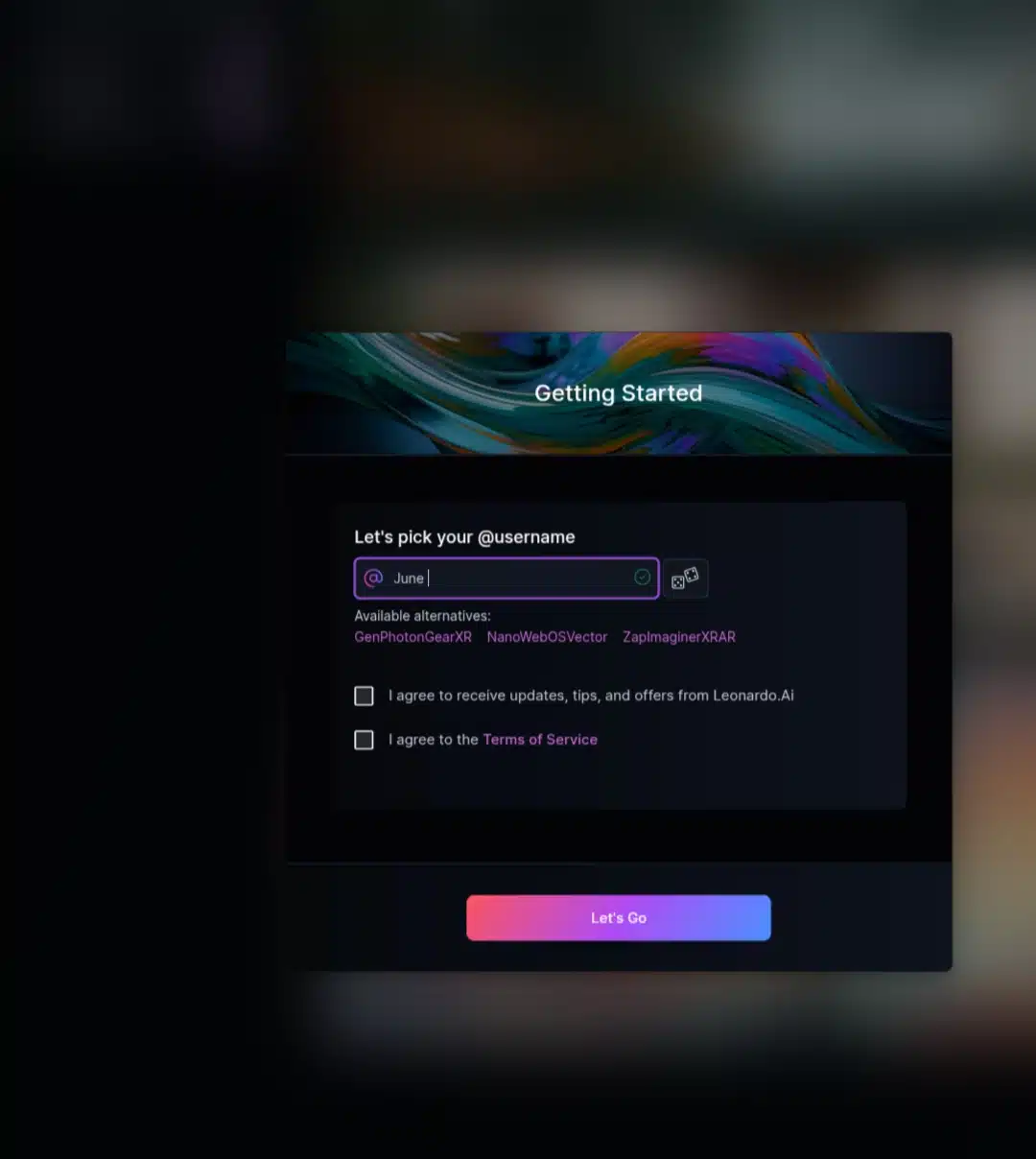

And then, I was on the Leonardo AI platform.
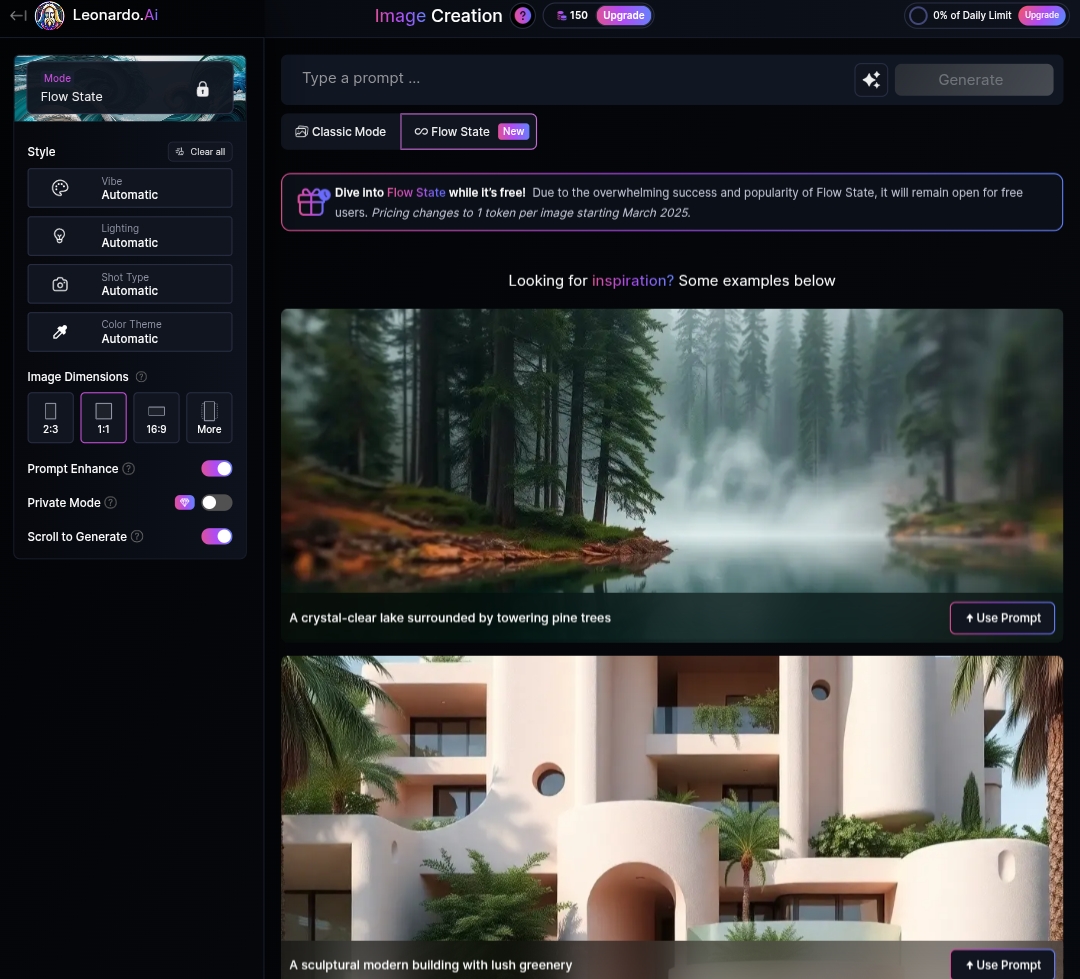

The minimal setup lasted less than 5 minutes, allowing me to dive into creating art quickly. However, as a beginner, the platform’s extensive customization options initially felt overwhelming, but I grasped it later.
Midjourney
I searched my web browser for “Midjourney AI sign up.” This was the first step to getting started. Then, I clicked on the first link that appeared in the search results. This took me to the official Midjourney page.
On the Midjourney page, I looked for the “Sign In” option, usually on the bottom right-hand side. This also serves as the sign-up button.
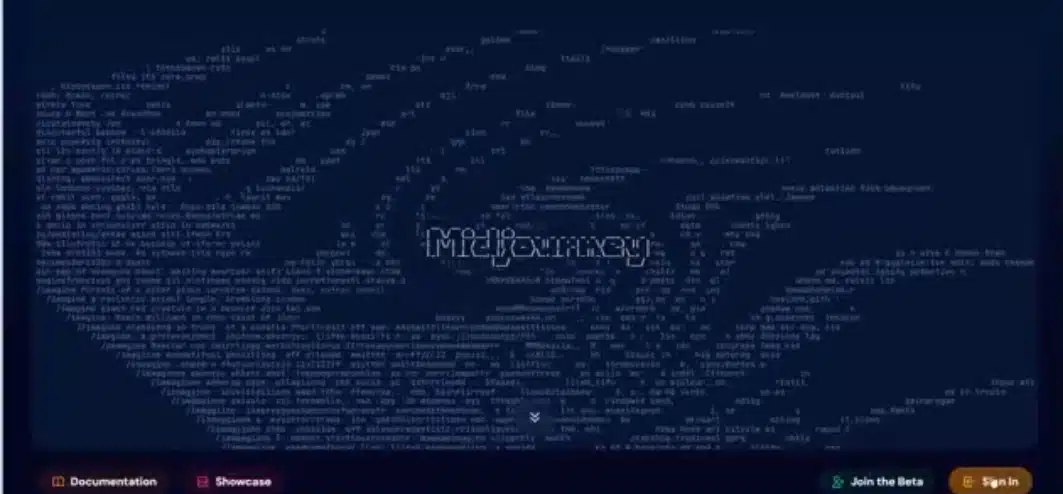

I clicked the “Sign In” button. This redirected me to the Discord login portal.
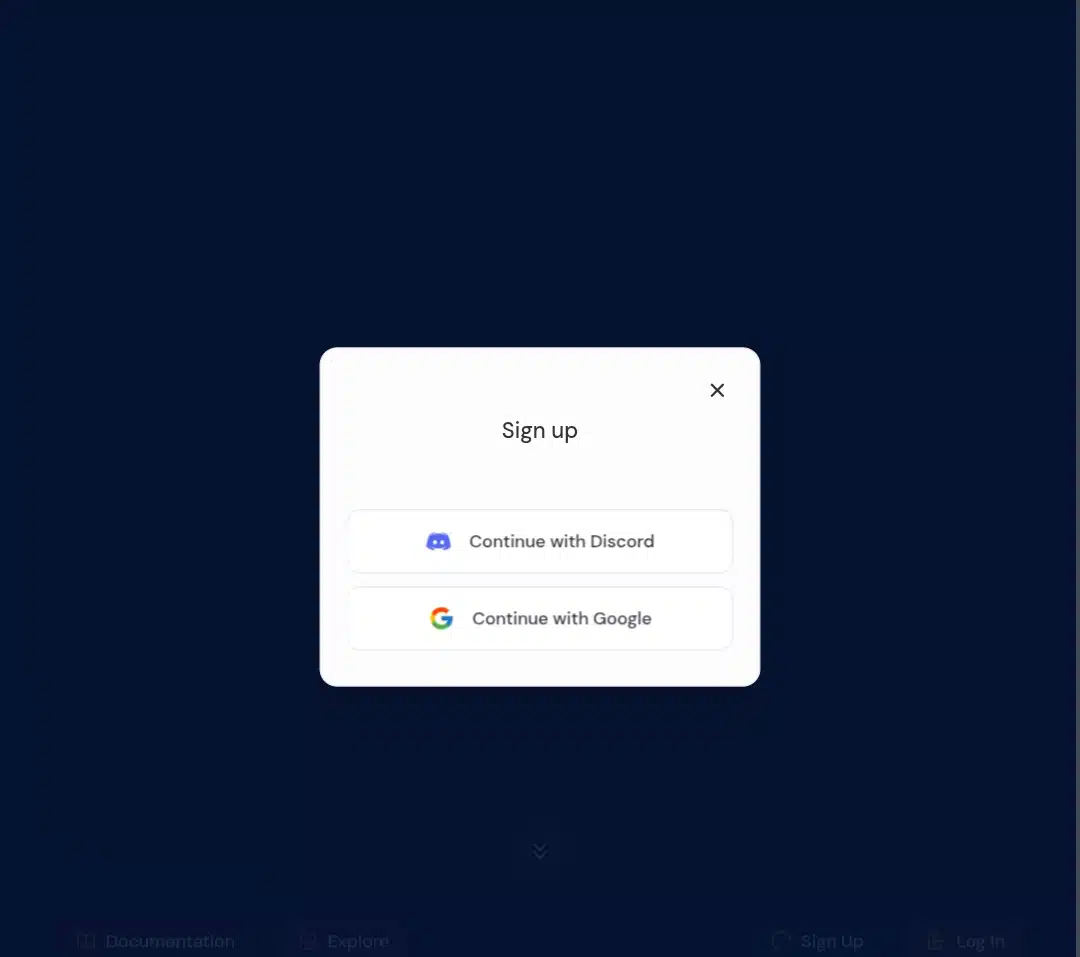

I needed a Discord account to sign in or sign up for Midjourney. If I didn’t already have one, I would need to create a Discord account first.
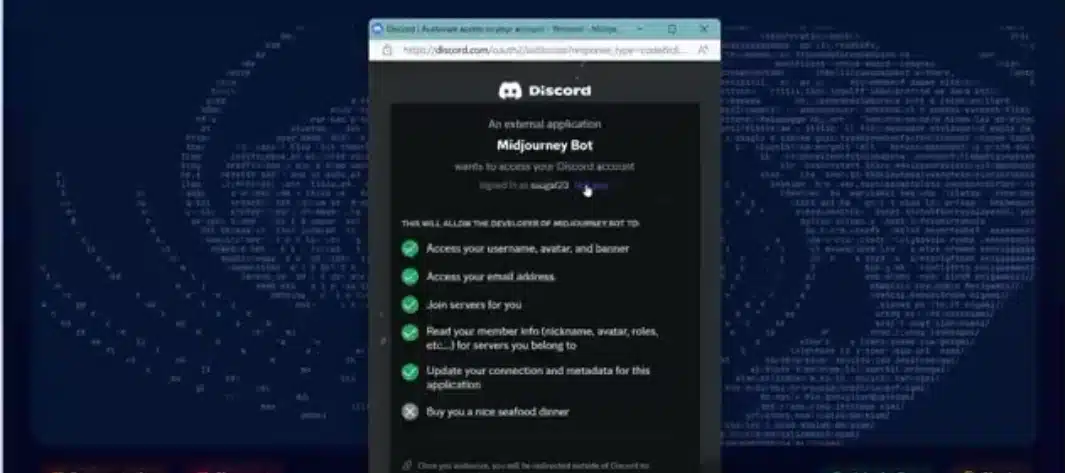

I entered my Discord email address or phone number in the first box and my password in the second box. Then, I clicked “Login”.
Discord detected my ID. I clicked “Authorize” to grant Midjourney access to my Discord account.
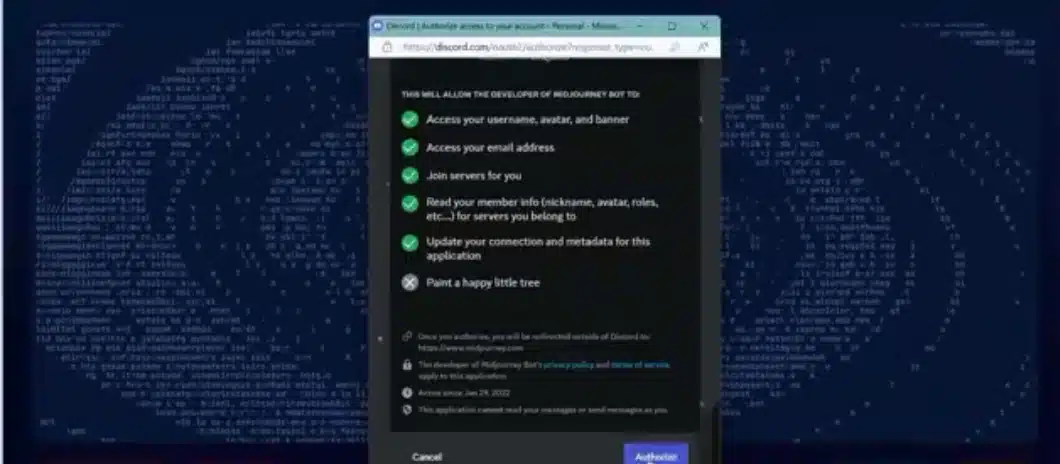

I gave it a moment, and soon, I was logged in and signed up for Midjourney using my Discord account.
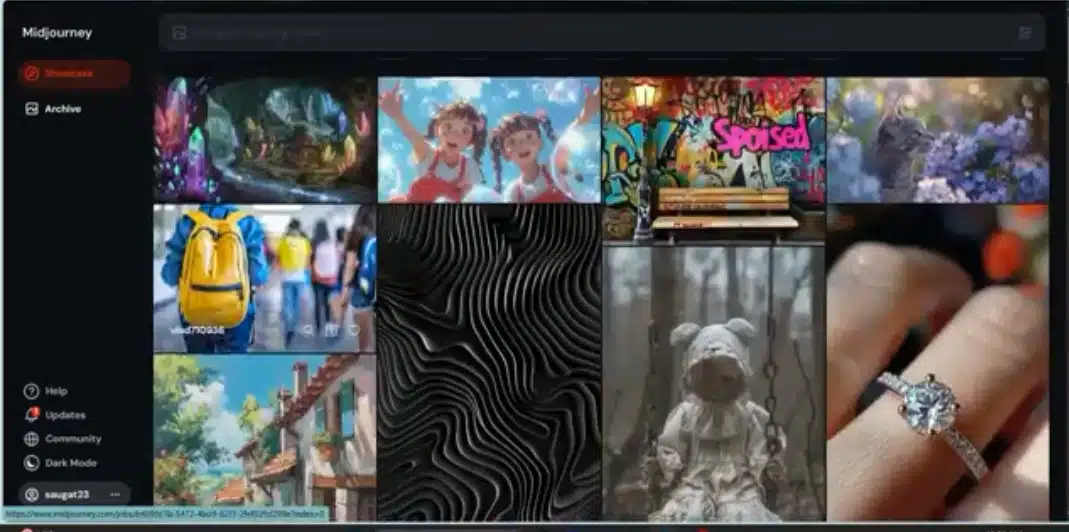

Like Leonardo AI, this process took less than 5 minutes.
Leonardo AI and Midjourney’s first impressions and ease of use
Upon launching Leonardo AI, the interface appears sleek and user-friendly, with straightforward navigation that facilitates quick exploration of its features. The platform’s focus on customization is evident, making it appealing to professionals seeking precise control over their art.
Midjourney’s Discord interface, while less visually polished, is surprisingly efficient once you grasp the command syntax. The community aspect is a significant plus, offering support and inspiration from fellow users.
Leonardo AI and Midjourney’s initial challenges
One of the initial challenges I encountered with Leonardo AI was navigating its vast array of customization options, which can be daunting and overwhelming for beginners. However, the platform’s documentation and tutorials help mitigate this issue.
For Midjourney, the primary challenge was adapting to the Discord text-based interface and understanding how to craft effective prompts to achieve the desired results as a first-timer. The community is helpful in this regard, but it took some time to get accustomed to the workflow.
Leonardo AI and Midjourney’s core features compared
Here are the core features I discovered in these two platforms:
Image quality & creativity
Leonardo AI consistently delivered high-resolution, photorealistic images, making it ideal for projects requiring detailed visuals. Its creative interpretations often added unique elements to the art.
Midjourney produced vibrant and dynamic artistic outputs, perfect for artistic experimentation. It offered a wide range of styles, often creating innovative pieces.
User interface and experience
This is where a significant difference exists. Leonardo AI offers a straightforward and intuitive interface, making it easy for both beginners and experienced users to navigate. The homepage clearly outlines all options, and a brief tutorial covers the basics upon sign-up. However, the extensive customization options might initially overwhelm newcomers.
Midjourney operates through Discord, requiring users to navigate both the platform and the Midjourney bot. While familiar users will find it accessible, newcomers may need time to adjust. The social aspect is integral, with a vibrant community providing guidance and feedback. All creations are public by default, fostering interaction and learning, but they have a downside that breeds no privacy, especially in the case of brand or highly classified generative assets.
Customization & prompt flexibility
Leonardo AI provided extensive customization options, allowing me to tweak and fine-tune style, mood, color, and other details. This flexibility was a significant draw for projects needing tailored visuals.
Midjourney also offered customization, though it was more dependent on text prompts. I could experiment with different styles by adjusting the prompt, but the level of control was not as creatively free as Leonardo AI.
Performance and speed
Leonardo AI
Fast Mode: Generates images in 10 to 20 seconds, ideal for quick prototyping with reduced quality and resolution.
Quality Mode: Typically takes 30 to 40 seconds to produce higher-quality images at higher resolutions.
Midjourney
Midjourney’s generation speed can vary based on the complexity of the prompt and the server load. Generally, generating an image takes a few minutes, but this can be longer if the server is busy or if the prompt is complex.
In summary, Leonardo AI is generally faster, especially in Fast mode, while Midjourney may take longer due to its detailed outputs and server load.
Subscription Plans
Leonardo AI
Leonardo AI offers a flexible pricing system based on an API credit model. This allows users to calculate costs based on their specific image generation needs. The platform includes a free tier with limited usage, followed by paid plans such as Apprentice, Artisan Unlimited, and Maestro Unlimited. These plans provide varying tokens and features, making them suitable for casual and serious users.
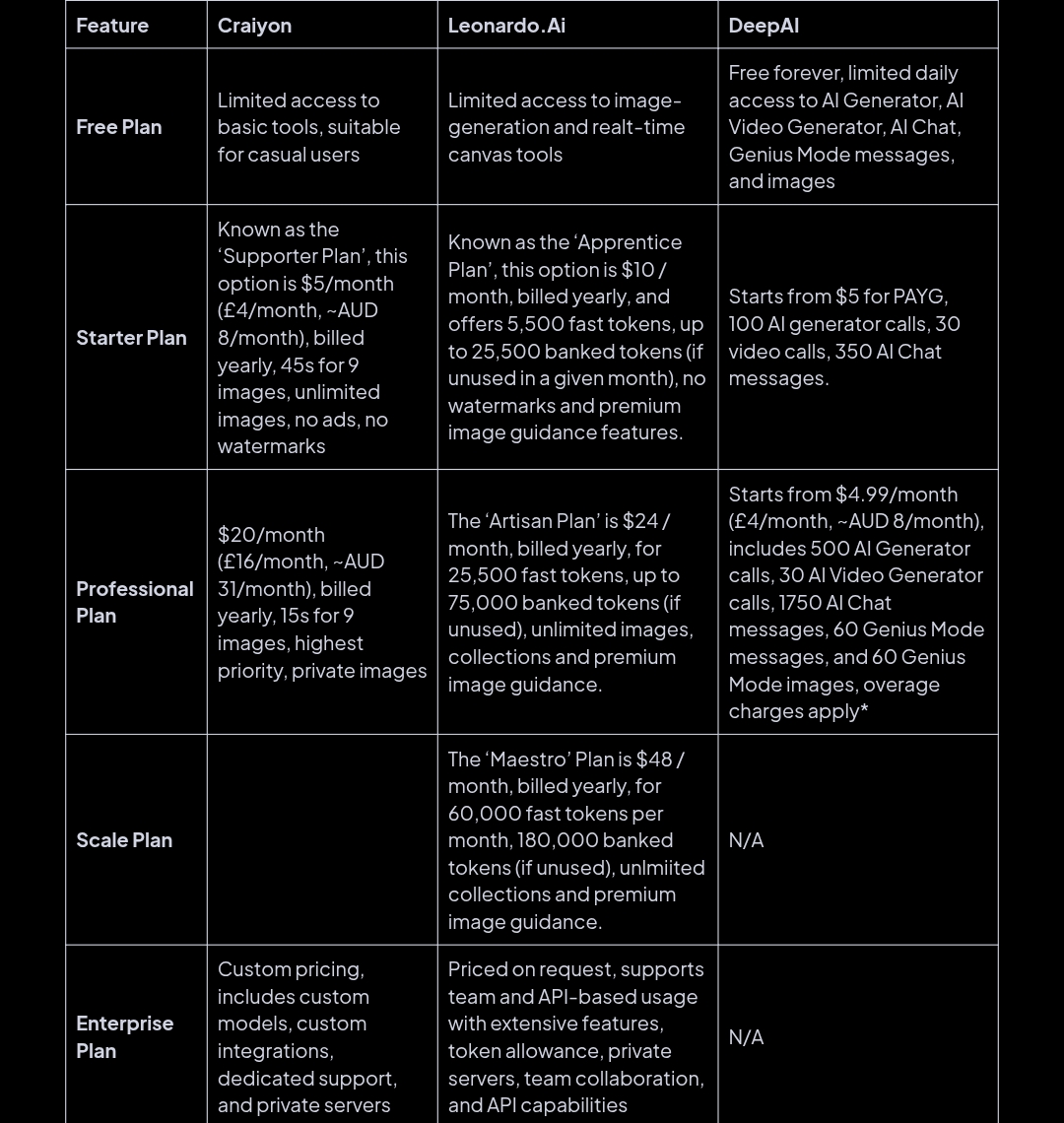

Midjourney
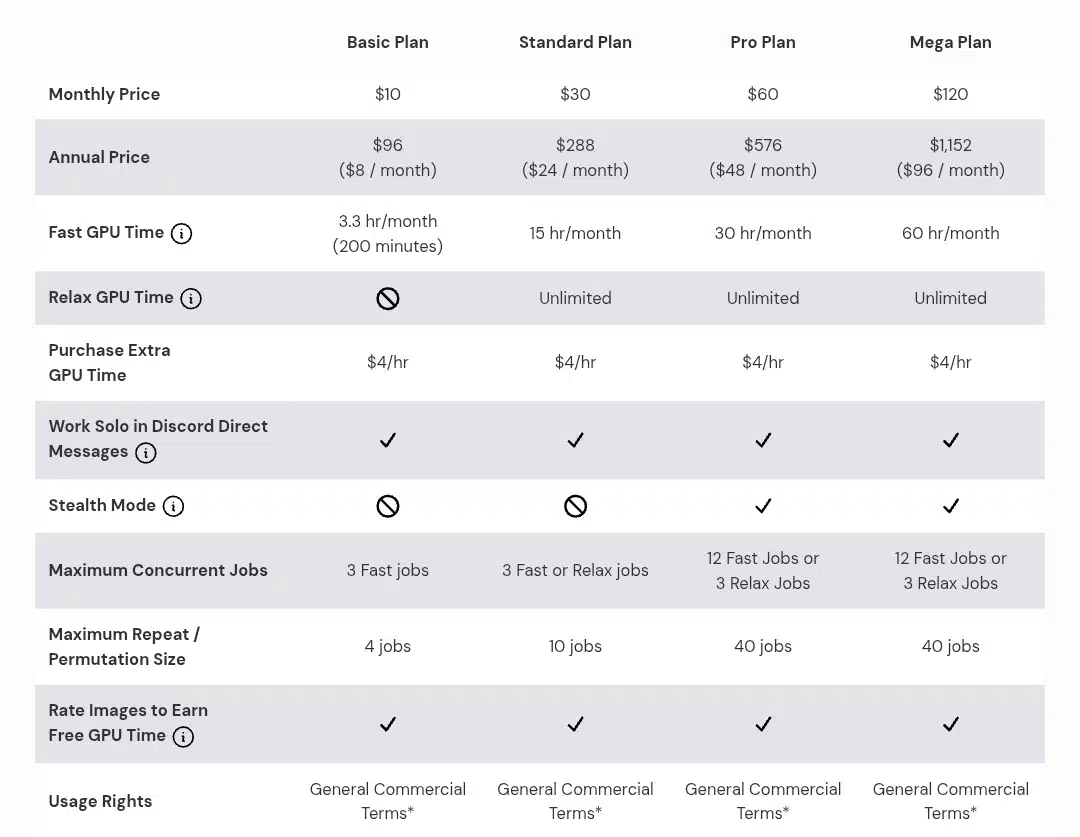

Midjourney, on the other hand, offers four distinct subscription tiers: Basic, Standard, Pro, and Mega. Prices range from $10 to $120 monthly, with discounts available for annual subscriptions. Each plan provides a different GPU time, with the Mega plan offering the most comprehensive features.
While Midjourney’s pricing is straightforward, Leonardo AI’s free tier provides greater accessibility. Leonardo’s paid tiers offer long-term value by potentially consolidating multiple subscription costs.
Community and resources
Both platforms provide excellent resources to help users get started. Midjourney offers getting-started guides covering Discord setup and prompt creation, supported by an active community. Leonardo AI features a comprehensive help center with FAQs, feature guides, and direct support via in-app messaging or a detailed Wiki for community mentorship.
Updated features
Leonardo AI
Leonardo Phoenix: The updated functionality offers enhanced coherence and clarity in text generation, addressing common challenges in AI image creation. Specifically, it provides solutions to longstanding issues, such as generating realistic hands and faces, ensuring that the outputs are more lifelike and visually appealing.
Midjourney
Midjourney 6.1: This updated feature significantly improved the accuracy of longer prompts, ensuring that the generated content remains coherent and aligned with the user’s intent. It also introduced advanced prompting and remixing capabilities, allowing for more sophisticated and creative outputs. Furthermore, new parameters were added to enable users to achieve more photographic or literal results, providing greater control over the final output.
Performance comparison table
| Features | Leonardo AI | Midjourney |
| Art quality and style | High-resolution, photorealistic | Vibrant, dynamic, artistic |
| Customization | Extensive options for style,mood, color | Dependent on text prompts, less granular control |
| Performance and speed | Quick image generation | Slightly slower, depending on the prompt simplicity and servers. |
| User Interface and Experience | User-friendly web interface | Text-based Discord interface |
| Community and resources | Limited community support | Strong community support |
| Cost | Affordable plans | Higher subscription price |
| Updated features | Leonardo Phoenix offers realistic and lifelike hands and faces. | Midjourney 6.1 ensures Long prompts results remain coherent and align with the user’s intent. |
My practical uses of Leonardo AI and Midjourney
1. Creating concept art for a fantasy novel
Project Goal: Design a mystical forest scene with a glowing tree at its center.
Leonardo AI prompt
“Generate a photorealistic image of a mystical forest with a glowing tree in the center. The tree should have a soft, ethereal glow. The forest should be dense with misty fog and tall, ancient trees. Include a winding path leading to the tree.”
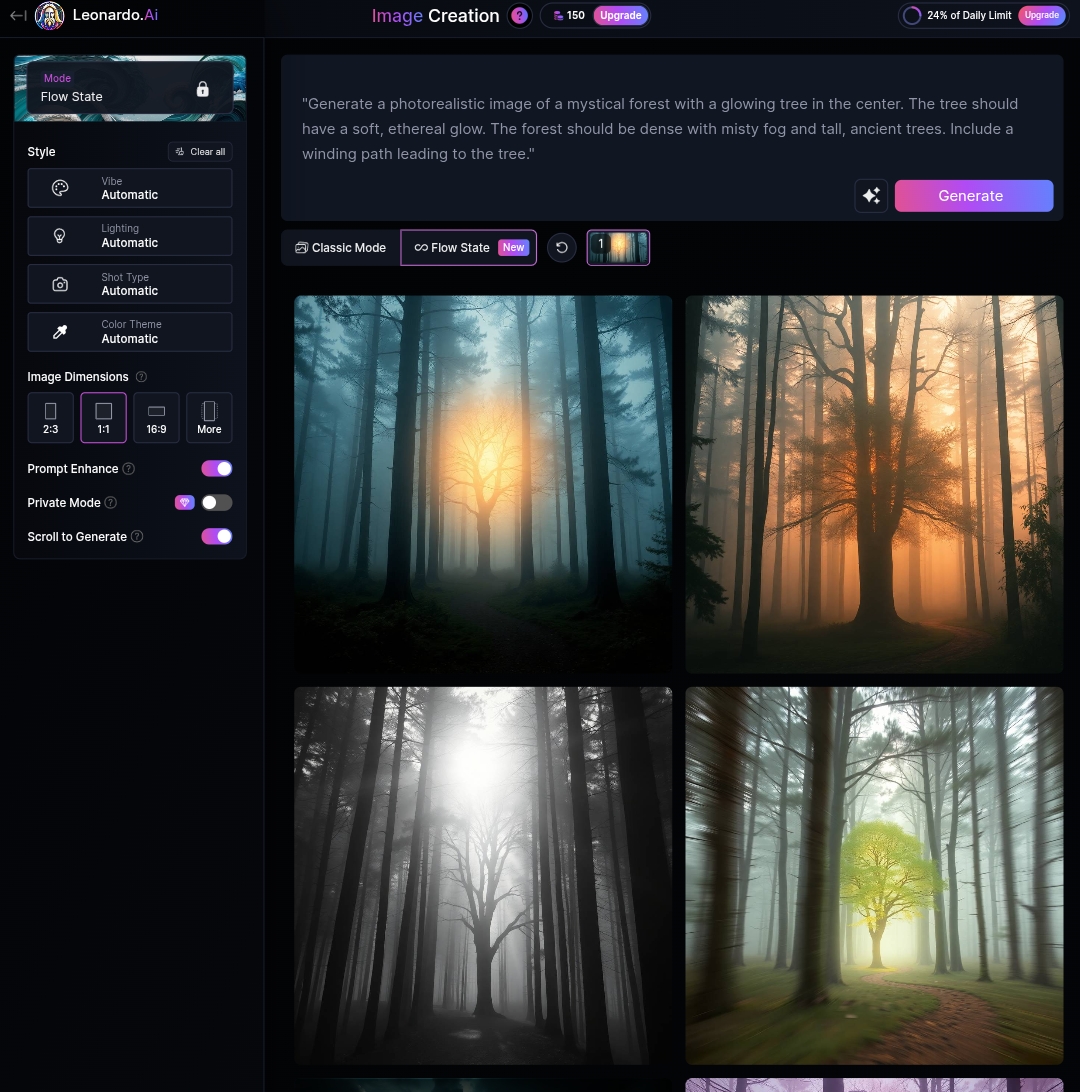

I used the free plan’s daily tokens to generate high-resolution images. The platform’s photorealistic capabilities allowed me to create detailed environments with realistic lighting. However, achieving the desired glow effect required several iterations.
Midjourney prompt
“/imagine a vibrant, mystical forest with a glowing tree at its center. The tree should have a radiant, pulsing glow. The forest should be filled with colorful, glowing mushrooms and misty fog. Include a winding path leading to the tree. –v 5 –ar 16:9”
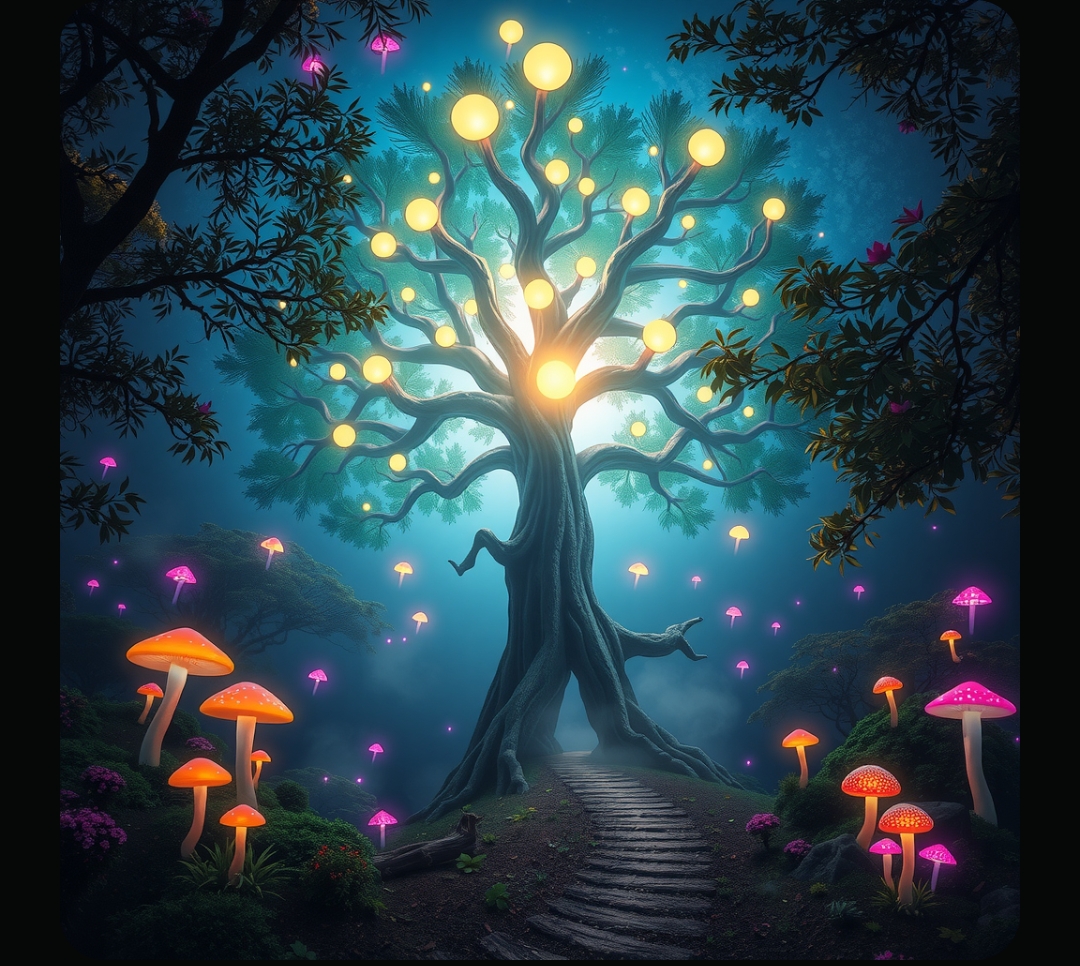

Although Midjourney no longer offers a free trial, I simulated this scenario using a friend’s account. Midjourney excelled in producing vibrant, artistic interpretations of the forest, but capturing the precise glow effect was challenging without extensive prompt tweaking.
Comparison: Leonardo AI provided more realistic environments, while Midjourney’s artistic style added a unique flair. Both platforms required some trial and error to achieve the desired effect.
2. Designing social media graphics
Project Goal: Create eye-catching social media graphics for a new product launch.
Leonardo AI prompt
“Generate a high-resolution social media graphic for a new tech product launch. The background should be a futuristic cityscape at sunset. Include the product logo prominently in the center with a bold, modern font. Use a color scheme of blue and silver.”
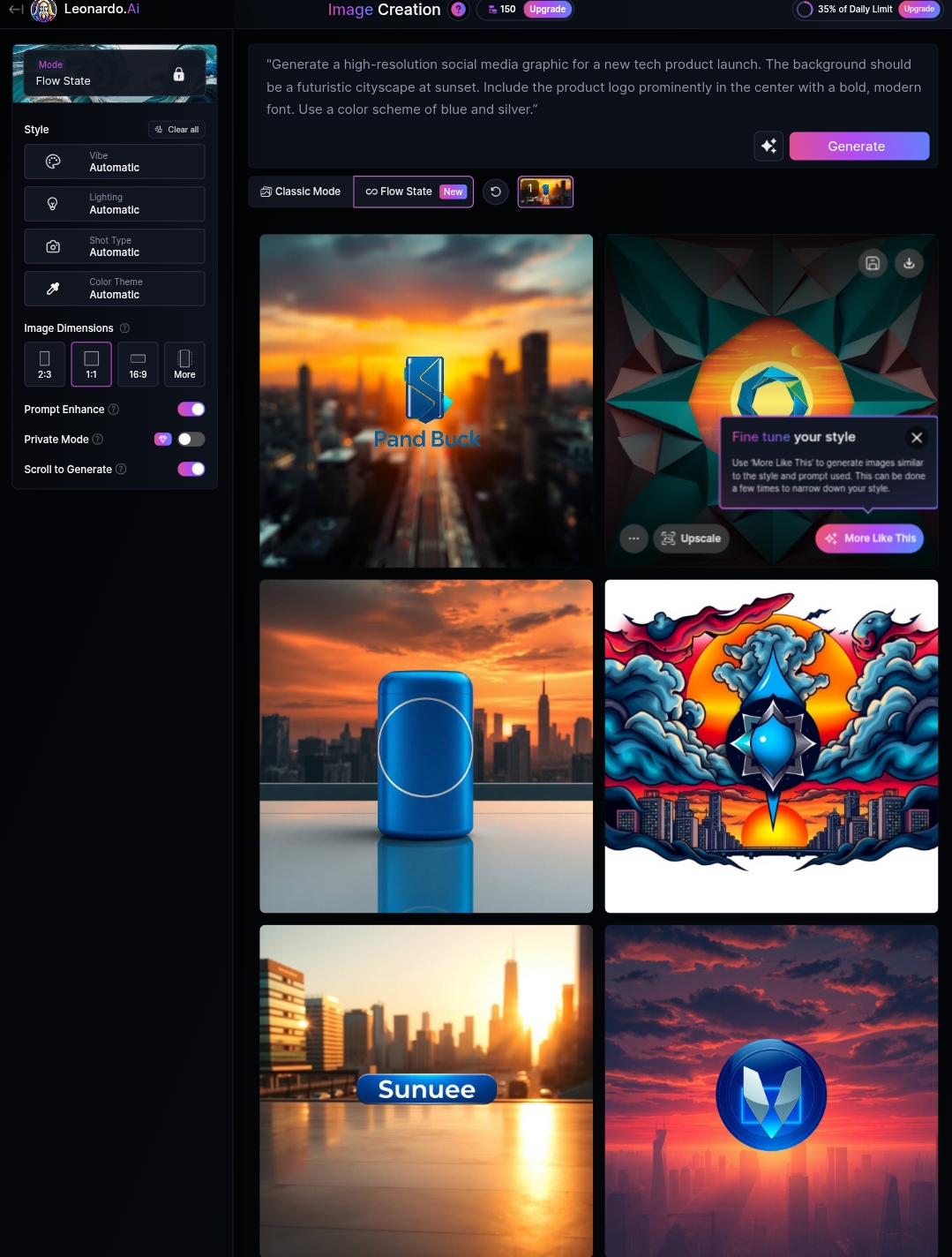

The free plan allowed me to generate high-quality graphics quickly. I used the platform’s customization options to match the brand’s color palette and style. The output was consistent and professional.
Midjourney prompt
“/imagine a vibrant social media graphic for a tech product launch. The background should be stylized, neon-lit cityscape at night. Include the product logo in a futuristic, 3D style. Use a bold, neon color scheme. –v 5 –ar 1:1”


Using a paid plan, I found Midjourney’s vibrant styles perfect for creating engaging social media graphics. The community aspect was invaluable for inspiration and feedback.
Comparison: Leonardo AI offered more control over branding elements, while Midjourney’s artistic outputs were more attention-grabbing. Both platforms delivered high-quality results, but Leonardo AI was more suitable for precise branding needs.
3. Generating abstract art for a personal project
Project goal: Create a series of abstract art pieces inspired by nature
Leonardo AI prompt
“Generate an abstract art piece inspired by a stormy sea. Use a palette of blues and greys. Include swirling patterns that evoke the movement of waves. The style should be reminiscent of impressionist paintings.”
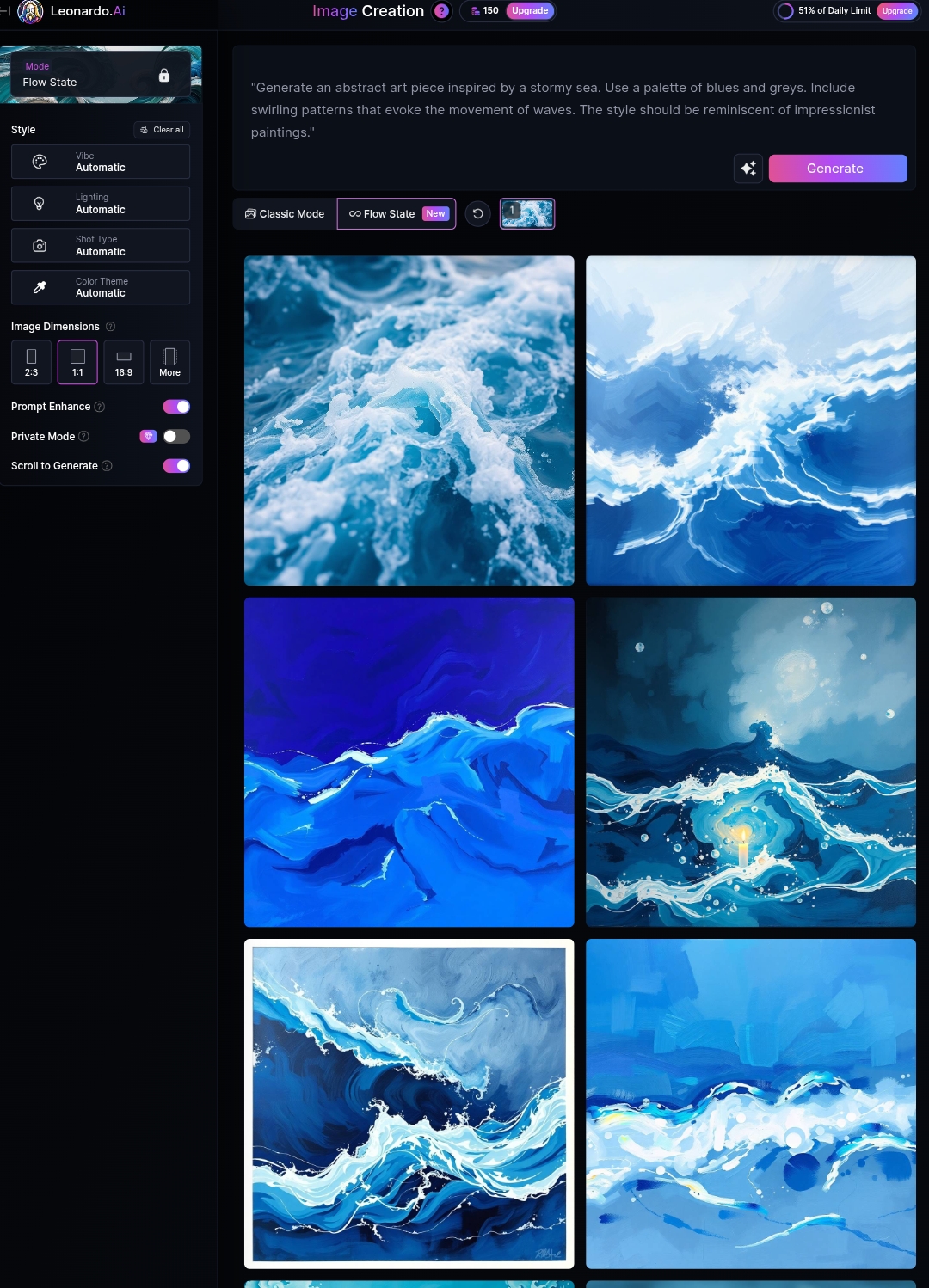

The free plan’s tokens were sufficient for experimenting with different styles and prompts. However, achieving truly abstract results required pushing the platform’s customization limits.
Midjourney prompt
“/imagine an abstract art piece inspired by a stormy sea. Use a vibrant palette of blues and greens. Include dynamic, swirling patterns that evoke the energy of waves. The style should be abstract expressionist. –v 5 –ar 4:3”


Midjourney excelled in this part, deploying easy insights into crafting effective prompts.
Comparison: Midjourney’s artistic flexibility made it ideal for abstract art, while Leonardo AI required more effort to achieve similar results. Both platforms offered unique strengths, but Midjourney’s outputs were more surprising and creative.
Consistency, variety, and satisfaction
Leonardo AI provided consistent results in terms of quality, though there was some variability in how well it interpreted prompts. The satisfaction level was high, especially for realistic projects.
Midjourney offered a wide variety of artistic styles, and the community aspect was invaluable for learning and inspiration. However, the quality could vary based on the prompt and server load.
What i liked about Leonardo AI
- Exceptional detail and creative interpretation: Leonardo AI’s ability to produce high-resolution images with impressive detail was a standout feature. Its creative interpretations often added unique elements to the art.
- Intuitive interface and customization options: The platform’s user-friendly interface made it easy to explore and utilize its extensive customization options, which will be invaluable for unprofessionals.
- Unique style elements: Leonardo AI’s photorealistic capabilities set it apart, making it ideal for projects requiring realistic visuals.
What i liked about Midjourney
- Consistently high-quality artistic outputs: Midjourney consistently produced vibrant and dynamic images perfect for artistic experimentation.
- Versatile prompt handling and vibrant styles: The platform’s ability to interpret a wide range of prompts and generate unique artistic styles was impressive.
- User-friendly community and supportive resources: The Discord community was a significant asset, providing support, inspiration, and a space to learn from others.
What i didn’t like about Leonardo AI and Midjourney (their notable inconsistencies)
Leonardo AI
- Output variability: While generally high-quality, there were instances where the output didn’t fully align with the prompt, requiring additional adjustments.
- Prompt control limitations: Despite extensive customization options, there were times when achieving specific artistic styles felt constrained by the platform’s interpretation of prompts.
Midjourney
- Slower processing in certain styles: While generally quick, generating images in more complex styles could take longer, especially during peak usage.
- Less flexibility in certain styles: Achieving specific photorealistic styles was challenging compared to Leonardo AI, as Midjourney excels more in artistic and vibrant outputs.
- No free plan: Unlike Leonardo AI, which offers a free plan for user experiments, Midjourney lacks this feature.
- Steep learning curve: As mentioned earlier, being a Discord first-timer made the learning duration slightly frustrating and time-consuming. Meanwhile, I made quick waves on Leonardo AI, played around the platform, and created AI art.
- Requires both a Midjourney and a Discord account with no standalone app or web platform. On the other hand, Leonardo AI is accessible through a web platform and requires no dependable account to work.
Final verdict: Leonardo AI vs. Midjourney, which tool is right for you?
The question doesn’t boil down to a “Yes” or “No” answer. Choosing between Leonardo AI and Midjourney depends on your specific creative needs.
Both platforms have their strengths and are suited for different types of projects. Leonardo AI excels in realism and customization, while Midjourney shines in artistic creativity and community support. Leonardo AI might be the preferred choice for those seeking a balance of quality and versatility. However, for artists who value community and rapid artistic experimentation, Midjourney is the way to go. Ultimately, choosing between these two powerful tools should be guided by your specific creative goals and preferences.
Conclusively,
| Choose Leonardo AI | Opt for Midjourney |
| If you’re looking for a user-friendly AI image generator that caters to diverse creative needs, offers extensive customization options, and allows for seamless iteration, making it ideal for beginners and professionals. | If you’re an artist interested in creating stunning, surreal AI art on a platform suited for collaborative projects, where you can engage with others and build upon their ideas to create unique artistic pieces. |
You may like
Noticias
Revivir el compromiso en el aula de español: un desafío musical con chatgpt – enfoque de la facultad
Published
6 meses agoon
6 junio, 2025
A mitad del semestre, no es raro notar un cambio en los niveles de energía de sus alumnos (Baghurst y Kelley, 2013; Kumari et al., 2021). El entusiasmo inicial por aprender un idioma extranjero puede disminuir a medida que otros cursos con tareas exigentes compitan por su atención. Algunos estudiantes priorizan las materias que perciben como más directamente vinculadas a su especialidad o carrera, mientras que otros simplemente sienten el peso del agotamiento de mediados de semestre. En la primavera, los largos meses de invierno pueden aumentar esta fatiga, lo que hace que sea aún más difícil mantener a los estudiantes comprometidos (Rohan y Sigmon, 2000).
Este es el momento en que un instructor de idiomas debe pivotar, cambiando la dinámica del aula para reavivar la curiosidad y la motivación. Aunque los instructores se esfuerzan por incorporar actividades que se adapten a los cinco estilos de aprendizaje preferidos (Felder y Henriques, 1995)-Visual (aprendizaje a través de imágenes y comprensión espacial), auditivo (aprendizaje a través de la escucha y discusión), lectura/escritura (aprendizaje a través de interacción basada en texto), Kinesthetic (aprendizaje a través de movimiento y actividades prácticas) y multimodal (una combinación de múltiples estilos)-its is beneficiales). Estructurado y, después de un tiempo, clases predecibles con actividades que rompen el molde. La introducción de algo inesperado y diferente de la dinámica del aula establecida puede revitalizar a los estudiantes, fomentar la creatividad y mejorar su entusiasmo por el aprendizaje.
La música, en particular, ha sido durante mucho tiempo un aliado de instructores que enseñan un segundo idioma (L2), un idioma aprendido después de la lengua nativa, especialmente desde que el campo hizo la transición hacia un enfoque más comunicativo. Arraigado en la interacción y la aplicación del mundo real, el enfoque comunicativo prioriza el compromiso significativo sobre la memorización de memoria, ayudando a los estudiantes a desarrollar fluidez de formas naturales e inmersivas. La investigación ha destacado constantemente los beneficios de la música en la adquisición de L2, desde mejorar la pronunciación y las habilidades de escucha hasta mejorar la retención de vocabulario y la comprensión cultural (DeGrave, 2019; Kumar et al. 2022; Nuessel y Marshall, 2008; Vidal y Nordgren, 2024).
Sobre la base de esta tradición, la actividad que compartiremos aquí no solo incorpora música sino que también integra inteligencia artificial, agregando una nueva capa de compromiso y pensamiento crítico. Al usar la IA como herramienta en el proceso de aprendizaje, los estudiantes no solo se familiarizan con sus capacidades, sino que también desarrollan la capacidad de evaluar críticamente el contenido que genera. Este enfoque los alienta a reflexionar sobre el lenguaje, el significado y la interpretación mientras participan en el análisis de texto, la escritura creativa, la oratoria y la gamificación, todo dentro de un marco interactivo y culturalmente rico.
Descripción de la actividad: Desafío musical con Chatgpt: “Canta y descubre”
Objetivo:
Los estudiantes mejorarán su comprensión auditiva y su producción escrita en español analizando y recreando letras de canciones con la ayuda de ChatGPT. Si bien las instrucciones se presentan aquí en inglés, la actividad debe realizarse en el idioma de destino, ya sea que se enseñe el español u otro idioma.
Instrucciones:
1. Escuche y decodifique
- Divida la clase en grupos de 2-3 estudiantes.
- Elija una canción en español (por ejemplo, La Llorona por chavela vargas, Oye CÓMO VA por Tito Puente, Vivir mi Vida por Marc Anthony).
- Proporcione a cada grupo una versión incompleta de la letra con palabras faltantes.
- Los estudiantes escuchan la canción y completan los espacios en blanco.
2. Interpretar y discutir
- Dentro de sus grupos, los estudiantes analizan el significado de la canción.
- Discuten lo que creen que transmiten las letras, incluidas las emociones, los temas y cualquier referencia cultural que reconocan.
- Cada grupo comparte su interpretación con la clase.
- ¿Qué crees que la canción está tratando de comunicarse?
- ¿Qué emociones o sentimientos evocan las letras para ti?
- ¿Puedes identificar alguna referencia cultural en la canción? ¿Cómo dan forma a su significado?
- ¿Cómo influye la música (melodía, ritmo, etc.) en su interpretación de la letra?
- Cada grupo comparte su interpretación con la clase.
3. Comparar con chatgpt
- Después de formar su propio análisis, los estudiantes preguntan a Chatgpt:
- ¿Qué crees que la canción está tratando de comunicarse?
- ¿Qué emociones o sentimientos evocan las letras para ti?
- Comparan la interpretación de ChatGPT con sus propias ideas y discuten similitudes o diferencias.
4. Crea tu propio verso
- Cada grupo escribe un nuevo verso que coincide con el estilo y el ritmo de la canción.
- Pueden pedirle ayuda a ChatGPT: “Ayúdanos a escribir un nuevo verso para esta canción con el mismo estilo”.
5. Realizar y cantar
- Cada grupo presenta su nuevo verso a la clase.
- Si se sienten cómodos, pueden cantarlo usando la melodía original.
- Es beneficioso que el profesor tenga una versión de karaoke (instrumental) de la canción disponible para que las letras de los estudiantes se puedan escuchar claramente.
- Mostrar las nuevas letras en un monitor o proyector permite que otros estudiantes sigan y canten juntos, mejorando la experiencia colectiva.
6. Elección – El Grammy va a
Los estudiantes votan por diferentes categorías, incluyendo:
- Mejor adaptación
- Mejor reflexión
- Mejor rendimiento
- Mejor actitud
- Mejor colaboración
7. Reflexión final
- ¿Cuál fue la parte más desafiante de comprender la letra?
- ¿Cómo ayudó ChatGPT a interpretar la canción?
- ¿Qué nuevas palabras o expresiones aprendiste?
Pensamientos finales: música, IA y pensamiento crítico
Un desafío musical con Chatgpt: “Canta y descubre” (Desafío Musical Con Chatgpt: “Cantar y Descubrir”) es una actividad que he encontrado que es especialmente efectiva en mis cursos intermedios y avanzados. Lo uso cuando los estudiantes se sienten abrumados o distraídos, a menudo alrededor de los exámenes parciales, como una forma de ayudarlos a relajarse y reconectarse con el material. Sirve como un descanso refrescante, lo que permite a los estudiantes alejarse del estrés de las tareas y reenfocarse de una manera divertida e interactiva. Al incorporar música, creatividad y tecnología, mantenemos a los estudiantes presentes en la clase, incluso cuando todo lo demás parece exigir su atención.
Más allá de ofrecer una pausa bien merecida, esta actividad provoca discusiones atractivas sobre la interpretación del lenguaje, el contexto cultural y el papel de la IA en la educación. A medida que los estudiantes comparan sus propias interpretaciones de las letras de las canciones con las generadas por ChatGPT, comienzan a reconocer tanto el valor como las limitaciones de la IA. Estas ideas fomentan el pensamiento crítico, ayudándoles a desarrollar un enfoque más maduro de la tecnología y su impacto en su aprendizaje.
Agregar el elemento de karaoke mejora aún más la experiencia, dando a los estudiantes la oportunidad de realizar sus nuevos versos y divertirse mientras practica sus habilidades lingüísticas. Mostrar la letra en una pantalla hace que la actividad sea más inclusiva, lo que permite a todos seguirlo. Para hacerlo aún más agradable, seleccionando canciones que resuenen con los gustos de los estudiantes, ya sea un clásico como La Llorona O un éxito contemporáneo de artistas como Bad Bunny, Selena, Daddy Yankee o Karol G, hace que la actividad se sienta más personal y atractiva.
Esta actividad no se limita solo al aula. Es una gran adición a los clubes españoles o eventos especiales, donde los estudiantes pueden unirse a un amor compartido por la música mientras practican sus habilidades lingüísticas. Después de todo, ¿quién no disfruta de una buena parodia de su canción favorita?
Mezclar el aprendizaje de idiomas con música y tecnología, Desafío Musical Con Chatgpt Crea un entorno dinámico e interactivo que revitaliza a los estudiantes y profundiza su conexión con el lenguaje y el papel evolutivo de la IA. Convierte los momentos de agotamiento en oportunidades de creatividad, exploración cultural y entusiasmo renovado por el aprendizaje.
Angela Rodríguez Mooney, PhD, es profesora asistente de español y la Universidad de Mujeres de Texas.
Referencias
Baghurst, Timothy y Betty C. Kelley. “Un examen del estrés en los estudiantes universitarios en el transcurso de un semestre”. Práctica de promoción de la salud 15, no. 3 (2014): 438-447.
DeGrave, Pauline. “Música en el aula de idiomas extranjeros: cómo y por qué”. Revista de Enseñanza e Investigación de Lenguas 10, no. 3 (2019): 412-420.
Felder, Richard M. y Eunice R. Henriques. “Estilos de aprendizaje y enseñanza en la educación extranjera y de segundo idioma”. Anales de idiomas extranjeros 28, no. 1 (1995): 21-31.
Nuessel, Frank y April D. Marshall. “Prácticas y principios para involucrar a los tres modos comunicativos en español a través de canciones y música”. Hispania (2008): 139-146.
Kumar, Tribhuwan, Shamim Akhter, Mehrunnisa M. Yunus y Atefeh Shamsy. “Uso de la música y las canciones como herramientas pedagógicas en la enseñanza del inglés como contextos de idiomas extranjeros”. Education Research International 2022, no. 1 (2022): 1-9
Noticias
5 indicaciones de chatgpt que pueden ayudar a los adolescentes a lanzar una startup
Published
6 meses agoon
5 junio, 2025

Teen emprendedor que usa chatgpt para ayudarlo con su negocio
El emprendimiento adolescente sigue en aumento. Según Junior Achievement Research, el 66% de los adolescentes estadounidenses de entre 13 y 17 años dicen que es probable que considere comenzar un negocio como adultos, con el monitor de emprendimiento global 2023-2024 que encuentra que el 24% de los jóvenes de 18 a 24 años son actualmente empresarios. Estos jóvenes fundadores no son solo soñando, están construyendo empresas reales que generan ingresos y crean un impacto social, y están utilizando las indicaciones de ChatGPT para ayudarlos.
En Wit (lo que sea necesario), la organización que fundó en 2009, hemos trabajado con más de 10,000 jóvenes empresarios. Durante el año pasado, he observado un cambio en cómo los adolescentes abordan la planificación comercial. Con nuestra orientación, están utilizando herramientas de IA como ChatGPT, no como atajos, sino como socios de pensamiento estratégico para aclarar ideas, probar conceptos y acelerar la ejecución.
Los emprendedores adolescentes más exitosos han descubierto indicaciones específicas que los ayudan a pasar de una idea a otra. Estas no son sesiones genéricas de lluvia de ideas: están utilizando preguntas específicas que abordan los desafíos únicos que enfrentan los jóvenes fundadores: recursos limitados, compromisos escolares y la necesidad de demostrar sus conceptos rápidamente.
Aquí hay cinco indicaciones de ChatGPT que ayudan constantemente a los emprendedores adolescentes a construir negocios que importan.
1. El problema del primer descubrimiento chatgpt aviso
“Me doy cuenta de que [specific group of people]
luchar contra [specific problem I’ve observed]. Ayúdame a entender mejor este problema explicando: 1) por qué existe este problema, 2) qué soluciones existen actualmente y por qué son insuficientes, 3) cuánto las personas podrían pagar para resolver esto, y 4) tres formas específicas en que podría probar si este es un problema real que vale la pena resolver “.
Un adolescente podría usar este aviso después de notar que los estudiantes en la escuela luchan por pagar el almuerzo. En lugar de asumir que entienden el alcance completo, podrían pedirle a ChatGPT que investigue la deuda del almuerzo escolar como un problema sistémico. Esta investigación puede llevarlos a crear un negocio basado en productos donde los ingresos ayuden a pagar la deuda del almuerzo, lo que combina ganancias con el propósito.
Los adolescentes notan problemas de manera diferente a los adultos porque experimentan frustraciones únicas, desde los desafíos de las organizaciones escolares hasta las redes sociales hasta las preocupaciones ambientales. Según la investigación de Square sobre empresarios de la Generación de la Generación Z, el 84% planea ser dueños de negocios dentro de cinco años, lo que los convierte en candidatos ideales para las empresas de resolución de problemas.
2. El aviso de chatgpt de chatgpt de chatgpt de realidad de la realidad del recurso
“Soy [age] años con aproximadamente [dollar amount] invertir y [number] Horas por semana disponibles entre la escuela y otros compromisos. Según estas limitaciones, ¿cuáles son tres modelos de negocio que podría lanzar de manera realista este verano? Para cada opción, incluya costos de inicio, requisitos de tiempo y los primeros tres pasos para comenzar “.
Este aviso se dirige al elefante en la sala: la mayoría de los empresarios adolescentes tienen dinero y tiempo limitados. Cuando un empresario de 16 años emplea este enfoque para evaluar un concepto de negocio de tarjetas de felicitación, puede descubrir que pueden comenzar con $ 200 y escalar gradualmente. Al ser realistas sobre las limitaciones por adelantado, evitan el exceso de compromiso y pueden construir hacia objetivos de ingresos sostenibles.
Según el informe de Gen Z de Square, el 45% de los jóvenes empresarios usan sus ahorros para iniciar negocios, con el 80% de lanzamiento en línea o con un componente móvil. Estos datos respaldan la efectividad de la planificación basada en restricciones: cuando funcionan los adolescentes dentro de las limitaciones realistas, crean modelos comerciales más sostenibles.
3. El aviso de chatgpt del simulador de voz del cliente
“Actúa como un [specific demographic] Y dame comentarios honestos sobre esta idea de negocio: [describe your concept]. ¿Qué te excitaría de esto? ¿Qué preocupaciones tendrías? ¿Cuánto pagarías de manera realista? ¿Qué necesitaría cambiar para que se convierta en un cliente? “
Los empresarios adolescentes a menudo luchan con la investigación de los clientes porque no pueden encuestar fácilmente a grandes grupos o contratar firmas de investigación de mercado. Este aviso ayuda a simular los comentarios de los clientes haciendo que ChatGPT adopte personas específicas.
Un adolescente que desarrolla un podcast para atletas adolescentes podría usar este enfoque pidiéndole a ChatGPT que responda a diferentes tipos de atletas adolescentes. Esto ayuda a identificar temas de contenido que resuenan y mensajes que se sienten auténticos para el público objetivo.
El aviso funciona mejor cuando se vuelve específico sobre la demografía, los puntos débiles y los contextos. “Actúa como un estudiante de último año de secundaria que solicita a la universidad” produce mejores ideas que “actuar como un adolescente”.
4. El mensaje mínimo de diseñador de prueba viable chatgpt
“Quiero probar esta idea de negocio: [describe concept] sin gastar más de [budget amount] o más de [time commitment]. Diseñe tres experimentos simples que podría ejecutar esta semana para validar la demanda de los clientes. Para cada prueba, explique lo que aprendería, cómo medir el éxito y qué resultados indicarían que debería avanzar “.
Este aviso ayuda a los adolescentes a adoptar la metodología Lean Startup sin perderse en la jerga comercial. El enfoque en “This Week” crea urgencia y evita la planificación interminable sin acción.
Un adolescente que desea probar un concepto de línea de ropa podría usar este indicador para diseñar experimentos de validación simples, como publicar maquetas de diseño en las redes sociales para evaluar el interés, crear un formulario de Google para recolectar pedidos anticipados y pedirles a los amigos que compartan el concepto con sus redes. Estas pruebas no cuestan nada más que proporcionar datos cruciales sobre la demanda y los precios.
5. El aviso de chatgpt del generador de claridad de tono
“Convierta esta idea de negocio en una clara explicación de 60 segundos: [describe your business]. La explicación debe incluir: el problema que resuelve, su solución, a quién ayuda, por qué lo elegirían sobre las alternativas y cómo se ve el éxito. Escríbelo en lenguaje de conversación que un adolescente realmente usaría “.
La comunicación clara separa a los empresarios exitosos de aquellos con buenas ideas pero una ejecución deficiente. Este aviso ayuda a los adolescentes a destilar conceptos complejos a explicaciones convincentes que pueden usar en todas partes, desde las publicaciones en las redes sociales hasta las conversaciones con posibles mentores.
El énfasis en el “lenguaje de conversación que un adolescente realmente usaría” es importante. Muchas plantillas de lanzamiento comercial suenan artificiales cuando se entregan jóvenes fundadores. La autenticidad es más importante que la jerga corporativa.
Más allá de las indicaciones de chatgpt: estrategia de implementación
La diferencia entre los adolescentes que usan estas indicaciones de manera efectiva y aquellos que no se reducen a seguir. ChatGPT proporciona dirección, pero la acción crea resultados.
Los jóvenes empresarios más exitosos con los que trabajo usan estas indicaciones como puntos de partida, no de punto final. Toman las sugerencias generadas por IA e inmediatamente las prueban en el mundo real. Llaman a clientes potenciales, crean prototipos simples e iteran en función de los comentarios reales.
Investigaciones recientes de Junior Achievement muestran que el 69% de los adolescentes tienen ideas de negocios, pero se sienten inciertos sobre el proceso de partida, con el miedo a que el fracaso sea la principal preocupación para el 67% de los posibles empresarios adolescentes. Estas indicaciones abordan esa incertidumbre al desactivar los conceptos abstractos en los próximos pasos concretos.
La imagen más grande
Los emprendedores adolescentes que utilizan herramientas de IA como ChatGPT representan un cambio en cómo está ocurriendo la educación empresarial. Según la investigación mundial de monitores empresariales, los jóvenes empresarios tienen 1,6 veces más probabilidades que los adultos de querer comenzar un negocio, y son particularmente activos en la tecnología, la alimentación y las bebidas, la moda y los sectores de entretenimiento. En lugar de esperar clases de emprendimiento formales o programas de MBA, estos jóvenes fundadores están accediendo a herramientas de pensamiento estratégico de inmediato.
Esta tendencia se alinea con cambios más amplios en la educación y la fuerza laboral. El Foro Económico Mundial identifica la creatividad, el pensamiento crítico y la resiliencia como las principales habilidades para 2025, la capacidad de las capacidades que el espíritu empresarial desarrolla naturalmente.
Programas como WIT brindan soporte estructurado para este viaje, pero las herramientas en sí mismas se están volviendo cada vez más accesibles. Un adolescente con acceso a Internet ahora puede acceder a recursos de planificación empresarial que anteriormente estaban disponibles solo para empresarios establecidos con presupuestos significativos.
La clave es usar estas herramientas cuidadosamente. ChatGPT puede acelerar el pensamiento y proporcionar marcos, pero no puede reemplazar el arduo trabajo de construir relaciones, crear productos y servir a los clientes. La mejor idea de negocio no es la más original, es la que resuelve un problema real para personas reales. Las herramientas de IA pueden ayudar a identificar esas oportunidades, pero solo la acción puede convertirlos en empresas que importan.
Noticias
Chatgpt vs. gemini: he probado ambos, y uno definitivamente es mejor
Published
6 meses agoon
5 junio, 2025
Precio
ChatGPT y Gemini tienen versiones gratuitas que limitan su acceso a características y modelos. Los planes premium para ambos también comienzan en alrededor de $ 20 por mes. Las características de chatbot, como investigaciones profundas, generación de imágenes y videos, búsqueda web y más, son similares en ChatGPT y Gemini. Sin embargo, los planes de Gemini pagados también incluyen el almacenamiento en la nube de Google Drive (a partir de 2TB) y un conjunto robusto de integraciones en las aplicaciones de Google Workspace.
Los niveles de más alta gama de ChatGPT y Gemini desbloquean el aumento de los límites de uso y algunas características únicas, pero el costo mensual prohibitivo de estos planes (como $ 200 para Chatgpt Pro o $ 250 para Gemini Ai Ultra) los pone fuera del alcance de la mayoría de las personas. Las características específicas del plan Pro de ChatGPT, como el modo O1 Pro que aprovecha el poder de cálculo adicional para preguntas particularmente complicadas, no son especialmente relevantes para el consumidor promedio, por lo que no sentirá que se está perdiendo. Sin embargo, es probable que desee las características que son exclusivas del plan Ai Ultra de Gemini, como la generación de videos VEO 3.
Ganador: Géminis
Plataformas
Puede acceder a ChatGPT y Gemini en la web o a través de aplicaciones móviles (Android e iOS). ChatGPT también tiene aplicaciones de escritorio (macOS y Windows) y una extensión oficial para Google Chrome. Gemini no tiene aplicaciones de escritorio dedicadas o una extensión de Chrome, aunque se integra directamente con el navegador.

(Crédito: OpenAI/PCMAG)
Chatgpt está disponible en otros lugares, Como a través de Siri. Como se mencionó, puede acceder a Gemini en las aplicaciones de Google, como el calendario, Documento, ConducirGmail, Mapas, Mantener, FotosSábanas, y Música de YouTube. Tanto los modelos de Chatgpt como Gemini también aparecen en sitios como la perplejidad. Sin embargo, obtiene la mayor cantidad de funciones de estos chatbots en sus aplicaciones y portales web dedicados.
Las interfaces de ambos chatbots son en gran medida consistentes en todas las plataformas. Son fáciles de usar y no lo abruman con opciones y alternar. ChatGPT tiene algunas configuraciones más para jugar, como la capacidad de ajustar su personalidad, mientras que la profunda interfaz de investigación de Gemini hace un mejor uso de los bienes inmuebles de pantalla.
Ganador: empate
Modelos de IA
ChatGPT tiene dos series primarias de modelos, la serie 4 (su línea de conversación, insignia) y la Serie O (su compleja línea de razonamiento). Gemini ofrece de manera similar una serie Flash de uso general y una serie Pro para tareas más complicadas.
Los últimos modelos de Chatgpt son O3 y O4-Mini, y los últimos de Gemini son 2.5 Flash y 2.5 Pro. Fuera de la codificación o la resolución de una ecuación, pasará la mayor parte de su tiempo usando los modelos de la serie 4-Series y Flash. A continuación, puede ver cómo funcionan estos modelos en una variedad de tareas. Qué modelo es mejor depende realmente de lo que quieras hacer.
Ganador: empate
Búsqueda web
ChatGPT y Gemini pueden buscar información actualizada en la web con facilidad. Sin embargo, ChatGPT presenta mosaicos de artículos en la parte inferior de sus respuestas para una lectura adicional, tiene un excelente abastecimiento que facilita la vinculación de reclamos con evidencia, incluye imágenes en las respuestas cuando es relevante y, a menudo, proporciona más detalles en respuesta. Gemini no muestra nombres de fuente y títulos de artículos completos, e incluye mosaicos e imágenes de artículos solo cuando usa el modo AI de Google. El abastecimiento en este modo es aún menos robusto; Google relega las fuentes a los caretes que se pueden hacer clic que no resaltan las partes relevantes de su respuesta.
Como parte de sus experiencias de búsqueda en la web, ChatGPT y Gemini pueden ayudarlo a comprar. Si solicita consejos de compra, ambos presentan mosaicos haciendo clic en enlaces a los minoristas. Sin embargo, Gemini generalmente sugiere mejores productos y tiene una característica única en la que puede cargar una imagen tuya para probar digitalmente la ropa antes de comprar.
Ganador: chatgpt
Investigación profunda
ChatGPT y Gemini pueden generar informes que tienen docenas de páginas e incluyen más de 50 fuentes sobre cualquier tema. La mayor diferencia entre los dos se reduce al abastecimiento. Gemini a menudo cita más fuentes que CHATGPT, pero maneja el abastecimiento en informes de investigación profunda de la misma manera que lo hace en la búsqueda en modo AI, lo que significa caretas que se puede hacer clic sin destacados en el texto. Debido a que es más difícil conectar las afirmaciones en los informes de Géminis a fuentes reales, es más difícil creerles. El abastecimiento claro de ChatGPT con destacados en el texto es más fácil de confiar. Sin embargo, Gemini tiene algunas características de calidad de vida en ChatGPT, como la capacidad de exportar informes formateados correctamente a Google Docs con un solo clic. Su tono también es diferente. Los informes de ChatGPT se leen como publicaciones de foro elaboradas, mientras que los informes de Gemini se leen como documentos académicos.
Ganador: chatgpt
Generación de imágenes
La generación de imágenes de ChatGPT impresiona independientemente de lo que solicite, incluso las indicaciones complejas para paneles o diagramas cómicos. No es perfecto, pero los errores y la distorsión son mínimos. Gemini genera imágenes visualmente atractivas más rápido que ChatGPT, pero rutinariamente incluyen errores y distorsión notables. Con indicaciones complicadas, especialmente diagramas, Gemini produjo resultados sin sentido en las pruebas.
Arriba, puede ver cómo ChatGPT (primera diapositiva) y Géminis (segunda diapositiva) les fue con el siguiente mensaje: “Genere una imagen de un estudio de moda con una decoración simple y rústica que contrasta con el espacio más agradable. Incluya un sofá marrón y paredes de ladrillo”. La imagen de ChatGPT limita los problemas al detalle fino en las hojas de sus plantas y texto en su libro, mientras que la imagen de Gemini muestra problemas más notables en su tubo de cordón y lámpara.
Ganador: chatgpt
¡Obtenga nuestras mejores historias!
Toda la última tecnología, probada por nuestros expertos
Regístrese en el boletín de informes de laboratorio para recibir las últimas revisiones de productos de PCMAG, comprar asesoramiento e ideas.
Al hacer clic en Registrarme, confirma que tiene más de 16 años y acepta nuestros Términos de uso y Política de privacidad.
¡Gracias por registrarse!
Su suscripción ha sido confirmada. ¡Esté atento a su bandeja de entrada!
Generación de videos
La generación de videos de Gemini es la mejor de su clase, especialmente porque ChatGPT no puede igualar su capacidad para producir audio acompañante. Actualmente, Google bloquea el último modelo de generación de videos de Gemini, VEO 3, detrás del costoso plan AI Ultra, pero obtienes más videos realistas que con ChatGPT. Gemini también tiene otras características que ChatGPT no, como la herramienta Flow Filmmaker, que le permite extender los clips generados y el animador AI Whisk, que le permite animar imágenes fijas. Sin embargo, tenga en cuenta que incluso con VEO 3, aún necesita generar videos varias veces para obtener un gran resultado.
En el ejemplo anterior, solicité a ChatGPT y Gemini a mostrarme un solucionador de cubos de Rubik Rubik que resuelva un cubo. La persona en el video de Géminis se ve muy bien, y el audio acompañante es competente. Al final, hay una buena atención al detalle con el marco que se desplaza, simulando la detención de una grabación de selfies. Mientras tanto, Chatgpt luchó con su cubo, distorsionándolo en gran medida.
Ganador: Géminis
Procesamiento de archivos
Comprender los archivos es una fortaleza de ChatGPT y Gemini. Ya sea que desee que respondan preguntas sobre un manual, editen un currículum o le informen algo sobre una imagen, ninguno decepciona. Sin embargo, ChatGPT tiene la ventaja sobre Gemini, ya que ofrece un reconocimiento de imagen ligeramente mejor y respuestas más detalladas cuando pregunta sobre los archivos cargados. Ambos chatbots todavía a veces inventan citas de documentos proporcionados o malinterpretan las imágenes, así que asegúrese de verificar sus resultados.
Ganador: chatgpt
Escritura creativa
Chatgpt y Gemini pueden generar poemas, obras, historias y más competentes. CHATGPT, sin embargo, se destaca entre los dos debido a cuán únicas son sus respuestas y qué tan bien responde a las indicaciones. Las respuestas de Gemini pueden sentirse repetitivas si no calibra cuidadosamente sus solicitudes, y no siempre sigue todas las instrucciones a la carta.
En el ejemplo anterior, solicité ChatGPT (primera diapositiva) y Gemini (segunda diapositiva) con lo siguiente: “Sin hacer referencia a nada en su memoria o respuestas anteriores, quiero que me escriba un poema de verso gratuito. Preste atención especial a la capitalización, enjambment, ruptura de línea y puntuación. Dado que es un verso libre, no quiero un medidor familiar o un esquema de retiro de la rima, pero quiero que tenga un estilo de coohes. ChatGPT logró entregar lo que pedí en el aviso, y eso era distinto de las generaciones anteriores. Gemini tuvo problemas para generar un poema que incorporó cualquier cosa más allá de las comas y los períodos, y su poema anterior se lee de manera muy similar a un poema que generó antes.
Recomendado por nuestros editores
Ganador: chatgpt
Razonamiento complejo
Los modelos de razonamiento complejos de Chatgpt y Gemini pueden manejar preguntas de informática, matemáticas y física con facilidad, así como mostrar de manera competente su trabajo. En las pruebas, ChatGPT dio respuestas correctas un poco más a menudo que Gemini, pero su rendimiento es bastante similar. Ambos chatbots pueden y le darán respuestas incorrectas, por lo que verificar su trabajo aún es vital si está haciendo algo importante o tratando de aprender un concepto.
Ganador: chatgpt
Integración
ChatGPT no tiene integraciones significativas, mientras que las integraciones de Gemini son una característica definitoria. Ya sea que desee obtener ayuda para editar un ensayo en Google Docs, comparta una pestaña Chrome para hacer una pregunta, pruebe una nueva lista de reproducción de música de YouTube personalizada para su gusto o desbloquee ideas personales en Gmail, Gemini puede hacer todo y mucho más. Es difícil subestimar cuán integrales y poderosas son realmente las integraciones de Géminis.
Ganador: Géminis
Asistentes de IA
ChatGPT tiene GPT personalizados, y Gemini tiene gemas. Ambos son asistentes de IA personalizables. Tampoco es una gran actualización sobre hablar directamente con los chatbots, pero los GPT personalizados de terceros agregan una nueva funcionalidad, como el fácil acceso a Canva para editar imágenes generadas. Mientras tanto, terceros no pueden crear gemas, y no puedes compartirlas. Puede permitir que los GPT personalizados accedan a la información externa o tomen acciones externas, pero las GEM no tienen una funcionalidad similar.
Ganador: chatgpt
Contexto Windows y límites de uso
La ventana de contexto de ChatGPT sube a 128,000 tokens en sus planes de nivel superior, y todos los planes tienen límites de uso dinámicos basados en la carga del servidor. Géminis, por otro lado, tiene una ventana de contexto de 1,000,000 token. Google no está demasiado claro en los límites de uso exactos para Gemini, pero también son dinámicos dependiendo de la carga del servidor. Anecdóticamente, no pude alcanzar los límites de uso usando los planes pagados de Chatgpt o Gemini, pero es mucho más fácil hacerlo con los planes gratuitos.
Ganador: Géminis
Privacidad
La privacidad en Chatgpt y Gemini es una bolsa mixta. Ambos recopilan cantidades significativas de datos, incluidos todos sus chats, y usan esos datos para capacitar a sus modelos de IA de forma predeterminada. Sin embargo, ambos le dan la opción de apagar el entrenamiento. Google al menos no recopila y usa datos de Gemini para fines de capacitación en aplicaciones de espacio de trabajo, como Gmail, de forma predeterminada. ChatGPT y Gemini también prometen no vender sus datos o usarlos para la orientación de anuncios, pero Google y OpenAI tienen historias sórdidas cuando se trata de hacks, filtraciones y diversos fechorías digitales, por lo que recomiendo no compartir nada demasiado sensible.
Ganador: empate
Related posts








































































































































































































































































































































Trending
-

 Startups2 años ago
Startups2 años agoRemove.bg: La Revolución en la Edición de Imágenes que Debes Conocer
-

 Tutoriales2 años ago
Tutoriales2 años agoCómo Comenzar a Utilizar ChatGPT: Una Guía Completa para Principiantes
-

 Startups1 año ago
Startups1 año agoStartups de IA en EE.UU. que han recaudado más de $100M en 2024
-

 Startups2 años ago
Startups2 años agoDeepgram: Revolucionando el Reconocimiento de Voz con IA
-

 Recursos2 años ago
Recursos2 años agoCómo Empezar con Popai.pro: Tu Espacio Personal de IA – Guía Completa, Instalación, Versiones y Precios
-

 Recursos2 años ago
Recursos2 años agoPerplexity aplicado al Marketing Digital y Estrategias SEO
-

 Estudiar IA2 años ago
Estudiar IA2 años agoCurso de Inteligencia Artificial de UC Berkeley estratégico para negocios
-

 Estudiar IA2 años ago
Estudiar IA2 años agoCurso de Inteligencia Artificial Aplicada de 4Geeks Academy 2024



















































































































































































































































































































































































































































































































































































































































































































































































































































































































































































































































































